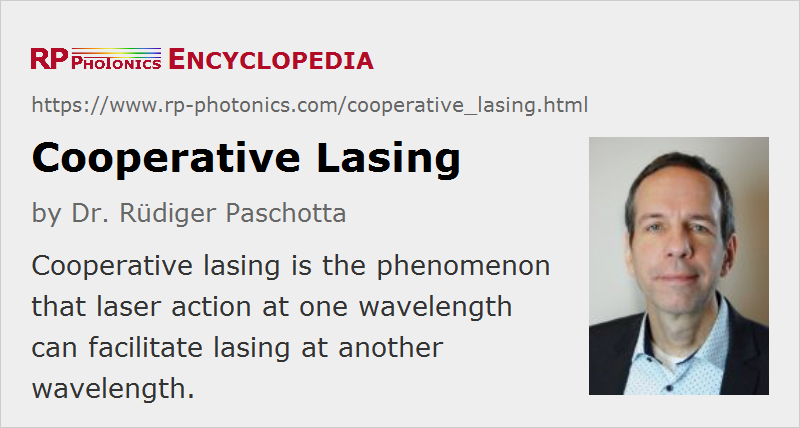Cooperative Lasing
Definition: the phenomenon that laser action at one wavelength can facilitate lasing at another wavelength
Alternative term: cascade lasing
German: kooperatives Lasen
Category:  laser devices and laser physics
laser devices and laser physics
Author: Dr. Rüdiger Paschotta
Cite the article using its DOI: https://doi.org/10.61835/r6p
Get citation code: Endnote (RIS) BibTex plain textHTML

There are level schemes of laser gain media where a laser transition is difficult to operate because the lower laser level has a high lifetime – possibly higher than that of the upper laser level. In such a situation, ions can accumulate in the lower laser level, so that the resulting reabsorption of laser light stops laser action soon after it started (→ self-terminating laser transitions). This can occur e.g. in some erbium- or thulium-doped heavy metal glasses (e.g. Er:ZBLAN, see also fluoride fibers). The problem can affect amplifiers in the same way as lasers.
Cooperative lasing (also called cascade lasing) constitutes one of several possibilities for solving that problem. Here, the lower laser level is depopulated by laser action on an additional laser transition to a still lower-lying energy level. This can be achieved by making the laser resonator so that it has low optical round-trip losses also at the wavelength of the additional laser transition. Ref. [3] presents an example, where cooperative lasing has permitted the operation of a fiber amplifier at 1.49 μm. Similarly, cooperative lasing has been applied to holmium [1] and erbium [2, 4] lasers.
More to Learn
Encyclopedia articles:
Bibliography
| [1] | M. C. Brierley et al., “Lasing at 2.08μm and 1.38μm in a holmium doped fluoro-zirconate fibre laser”, Electron. Lett. 245 (9), 539 (1988); https://doi.org/10.1049/el:19880365 |
| [2] | M. Pollnau et al., “Three-transition cascade erbium laser at 1.7, 2.7, and 1.6 μm”, Opt. Lett. 22 (9), 612 (1997); https://doi.org/10.1364/OL.22.000612 |
| [3] | S. Tessarin et al., “Tm3+-doped ZBLAN fibre amplifier at 1.49 μm with co-operative lasing at 1.88 μm”, Electron. Lett. 41 (16), 23 (2005); https://doi.org/10.1049/el:20052015 |
| [4] | S. D. Jackson, “High-power erbium cascade fibre laser”, Electron. Lett. 45 (16), 830 (2009); https://doi.org/10.1049/el.2009.1526 |
Questions and Comments from Users
Here you can submit questions and comments. As far as they get accepted by the author, they will appear above this paragraph together with the author’s answer. The author will decide on acceptance based on certain criteria. Essentially, the issue must be of sufficiently broad interest.
Please do not enter personal data here; we would otherwise delete it soon. (See also our privacy declaration.) If you wish to receive personal feedback or consultancy from the author, please contact him, e.g. via e-mail.
By submitting the information, you give your consent to the potential publication of your inputs on our website according to our rules. (If you later retract your consent, we will delete those inputs.) As your inputs are first reviewed by the author, they may be published with some delay.


Share this with your friends and colleagues, e.g. via social media:
These sharing buttons are implemented in a privacy-friendly way!